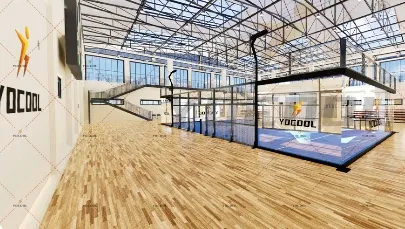

The world of racket sports has undergone a transformation, with padel rapidly becoming a favored choice across global sports complexes, clubs, and recreational venues. As demand surges, the development of high-performance courts tailored for tennis squash padel integration is reshaping the way these facilities operate. Unlike traditional courts that cater to a single sport, modern infrastructure now emphasizes multi-functionality, endurance, and user engagement. This industrial-grade evolution calls for precision in materials, design, and execution—where court construction is not just a service but a specialized engineering endeavor.

Designing shared spaces that accommodate tennis squash padel requires meticulous planning, especially in industrial or high-traffic sports environments. The interplay between surface texture, rebound consistency, and player safety determines long-term value. Most commercial facilities now implement synthetic turf or high-density resin surfaces, which are engineered to withstand repeated impact and diverse game mechanics. When configuring multi-racket courts, it's essential that the installation allows quick adjustments for different games without compromising structural integrity or playability.
One of the key considerations when constructing the court padel in industrial or commercial environments is the balance between rigidity and adaptability. Industrial venues often require courts that can endure heavy usage, frequent cleaning, and occasional modification. Materials such as galvanized steel frames, reinforced glass panels, and modular flooring systems ensure that the court padel remains both functional and aesthetically appealing over time. These courts are typically enclosed within safety glass walls, enhancing visibility for spectators while maintaining a confined and controlled play area for athletes.
Building the padel court involves more than laying down turf or erecting boundaries—it’s a comprehensive engineering process that accounts for drainage, lighting, ventilation, and environmental impact. For industrial-scale installations, the sub-structure plays a critical role in the court’s durability and performance. Reinforced concrete bases are often used to provide a stable platform, over which synthetic layers and mesh-based shock absorption systems are applied. In this way, the padel court becomes a resilient, low-maintenance asset capable of handling diverse weather conditions and high player traffic.
Partnering with professionals such as the padel court company for large-scale sports infrastructure ensures adherence to industry standards, safety regulations, and modern design expectations. These companies provide not only construction expertise but also consultation on layout efficiency, fencing systems, and LED-based court lighting. Whether it’s an indoor facility inside a warehouse or an open-air complex in a commercial recreation zone, the role of the padel court company extends from feasibility studies to post-construction maintenance. Their industrial insight guarantees optimal functionality and user satisfaction.
Determining padel court cost is essential for budget planning in industrial and commercial projects. The price typically varies depending on materials used, size (single or double court), accessories (such as seating and lighting), and installation complexity. On average, padel court cost includes structural foundation, fencing, artificial grass, glass walls, posts, net systems, and labor. High-end installations may also factor in climate-control systems, digital access control, and branding opportunities. Understanding the return on investment—through rentals, memberships, or tournaments—helps industrial planners justify the initial expense.
An official padel court measures 10 meters wide by 20 meters long, enclosed with walls that form part of the game. For multi-court industrial facilities, layout planning is crucial to ensure efficient space use, safe walkways, and spectator areas.
Timelines vary depending on whether the court is indoor or outdoor. Generally, the process takes between 4 to 8 weeks from groundwork to final finish, including surface curing and structural assembly.
Materials typically include galvanized steel for frames, tempered glass for walls, synthetic turf with silica infill for surface, and stainless steel or aluminum fencing. These ensure the court resists weathering, deformation, and corrosion.
Industrial-grade LED floodlights enhance visibility during evening play, reduce energy costs, and provide even distribution of light without glares or shadows. Modern systems often integrate with motion sensors or smart scheduling software.
Q: Is it possible to combine tennis squash padel in one commercial complex?
A: Yes, with modular court designs and adjustable net systems, facilities can host all three games with minimal structural changes, maximizing space and usage flexibility.
Q: How does the court padel differ from traditional tennis courts in industrial design?
A: The padel court is smaller, enclosed with walls, and has a net height of 88 cm at the center. Unlike tennis, padel courts must withstand wall-rebound play and are designed accordingly.
Q: Can the padel court company assist with international standards compliance?
A: Absolutely. Reputable builders ensure adherence to specifications set by governing bodies like FIP (International Padel Federation), covering dimensions, safety, and material guidelines.
Q: What is the average padel court cost for a commercial project?
A: Costs can range from $20,000 to $50,000 per court, depending on customization, indoor or outdoor setup, and local labor rates. Additional expenses may include lighting, seating, and climate control.
Q: Are padel courts suitable for rooftop or indoor industrial installations?
A: Yes, with proper structural analysis, lightweight court designs, and modular construction, padel courts can be installed on rooftops, mezzanines, or warehouse interiors efficiently.
Starts with Strategic Padel Court Solutions
Sports Facilities with Innovative Padel Court Construction
Revolutionize Sports Facilities with Custom Padel Court Construction
Master Industrial Racquetball Performance with Professional Equipment
Industrial Expansion Begins with Strategic Padel Court Construction Investments
Construct Future-Ready Sports Facilities with Industrial-Grade Padel Courts